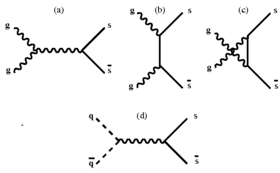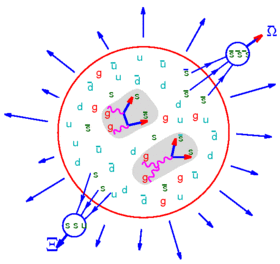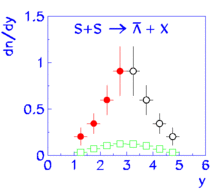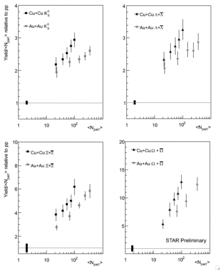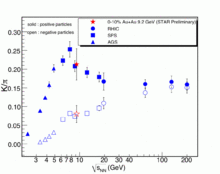Physics:Strangeness production
Strangeness production is a signature and a diagnostic tool of quark–gluon plasma (or QGP) formation and properties. Unlike up and down quarks, from which everyday matter is made, strange quarks are formed in pair-production processes in collisions between constituents of the plasma. The dominant mechanism of production involves gluons only present when matter has become a quark–gluon plasma. When quark–gluon plasma disassembles into hadrons in a breakup process, the high availability of strange antiquarks helps to produce antimatter containing multiple strange quarks, which is otherwise rarely made. Similar considerations are at present made for the heavier charm flavor, which is made at the beginning of the collision process in the first interactions and is only abundant in the high-energy environments of CERN's Large Hadron Collider.
Matter formation in the early universe
The majority of ordinary matter in the universe is found in atomic nuclei, which are made of neutrons and protons. These neutrons and protons are made up of smaller particles called quarks. For every type of matter particle there is a corresponding antiparticle with the same mass and the opposite charge. It is hypothesized that during the first few instants of the universe, it was composed of almost equal amounts of matter and antimatter, and thus contained nearly equal number of quarks and antiquarks.[1] Once the universe expanded and cooled to a critical temperature of approximately 2×1012 K,[citation needed] quarks combined into normal matter and antimatter. Antimatter annihilated with matter up to the small initial asymmetry of about one part in five billion, leaving the matter around us.[citation needed] Free and separate individual quarks and antiquarks have never been observed in experiments—quarks and antiquarks are always found in groups of three (baryons), or bound in quark–antiquark pairs (mesons).
Quark–gluon plasma in the early universe and in the laboratory
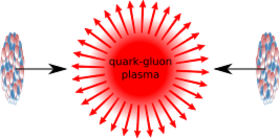
Free quarks probably existed in the extreme conditions of the very early universe until about 30 microseconds after the Big Bang,[2] in a very hot gas of free quarks, antiquarks and gluons. This gas is called a quark–gluon plasma (QGP), since the quark-interaction charge (color charge) is mobile and quarks and gluons move around. This is possible because at a high temperature the early universe is in a different vacuum state, in which normal matter cannot exist but quarks and gluons can, they are deconfined (able to exist independently as separate unbound particles). In order to recreate this deconfined phase of matter in the laboratory it is necessary to exceed a minimum temperature, or its equivalent, a minimum energy density. Scientists achieve this using particle collisions at extremely high speeds, where the energy released in the collision can raise the subatomic particles' energies to an exceedingly high level, sufficient for them to briefly form a tiny amount of quark-gluon plasma which can be studied for a brief fraction of a second[specify] before it cools again. In this way, it is possible to study conditions akin to those in the early Universe at the age of 10–40 microseconds. Discovery of this new QGP state of matter has been announced both at CERN and at Brookhaven National Laboratory (BNL). At this time comprehensive experimental evidence about its properties is being assembled.
The process of the formation of quark–gluon plasma lasts little longer than the time the light takes to pass through the volume occupied by the atomic nucleus used to produce the ultra-high pressure and temperature in the highly-energetic collision. After this brief time the hot drop of quark plasma evaporates in a process called hadronization. The extremely limited duration of the plasma makes it challenging (difficult) to study free quarks in quark–gluon plasma.
Strangeness in quark–gluon plasma
The diagnosis and the study of the properties of quark–gluon plasma can be undertaken using quarks not present in matter seen around us. The experimental and theoretical work relies on the idea of strangeness enhancement. This was the first observable of quark–gluon plasma proposed in 1980 by Johann Rafelski and Rolf Hagedorn.[3] Unlike the up and down quarks, strange quarks are not brought into the reaction by the colliding nuclei. Therefore, any strange quarks or antiquarks observed in experiments have been "freshly" made from the kinetic energy of colliding nuclei. Conveniently, the mass of strange quarks and antiquarks is equivalent to the temperature or energy at which protons, neutrons and other hadrons dissolve into quarks. This means that the abundance of strange quarks is sensitive to the conditions, structure and dynamics of the deconfined matter phase, and if their number is large it can be assumed that deconfinement conditions were reached.[citation needed]
Production of strangeness in the thermal collision process
One cannot assume that under all conditions the yield of strange quarks is in thermal equilibrium. In general, the quark-flavor composition of the plasma varies during its ultra short lifetime as new flavors of quarks such as strangeness are cooked up inside. The up and down quarks from which normal matter is made are easily produced as quark-antiquark pairs in the hot fireball because they have small masses. On the other hand, the next lightest quark flavor, strange quarks, will reach its high quark–gluon plasma thermal abundance only on the most violent collisions generating high temperatures and that at the end of the cooking process.[clarification needed]
Gluon fusion into strangeness
This is only possible due to a new process, the gluon fusion, as shown by Rafelski and Müller in 1981.[4] The top section of the figure shows gluon fusion in form of Feynman diagrams: gluons are the wavy lines; strange quarks are the solid lines; time runs from left to right. The bottom section is the process where the heavier quark pair arises from the lighter pair of quarks shown as dashed lines. The gluon fusion process occurs almost ten times faster than the quark based strangeness process, and allows achievement of the high thermal yield where the quark based process would fail to do so during the duration of the "micro-bang".[5] The gluon collisions here are occurring within the thermal matter phase and are thus different from the high energy processes that can ensue in the early stages of the collisions when the nuclei crash into each other. The heavier, charm and bottom quarks are produced there dominantly. The study in relativistic nuclear (heavy ion) collisions of charmed and soon also bottom hadronic particle production beside strangeness will provide complementary and important confirmation of the mechanisms of formation, evolution and hadronization of quark gluon plasma.[citation needed]
Strangeness (and charm) hadronization
These newly cooked strange quarks find their way into a multitude of different final particles that emerge as the hot quark–gluon plasma fireball breaks up, see the scheme of different processes in figure. Given the ready supply of antiquarks in the "fireball", one also finds a multitude of antimatter particles containing more than one strange quark. On the other hand, in a system involving a cascade of nucleon-nucleon collisions, multi-strange antimatter are produced less frequently considering that several relatively improbable events must occur in the same collision process. For this reason one expects that the yield of multi-strange antimatter particles produced in the presence of quark matter is enhanced compared to conventional series of reactions.[citation needed]
Strange quarks also bind with the heavier charm and bottom quarks which also like to bind with each other. Thus in presence of a large number of these quarks quite unusually abundant exotic particles can be produced, some of these have never been observed before. This should be the case in the forthcoming exploration at the new Large Hadron Collider at CERN of the particles that have both charm and strange quarks, and even bottom quarks as components.
Strange hadron decay and observation
Strange quarks are naturally radioactive and decay by weak interactions into lighter quarks on a timescale that is extremely long compared with the nuclear-collision times. This makes it relatively easy to detect strange particles through the tracks left by their decay products. Consider as example the decay of a negatively charged Xi baryon (green in figure, dss), into a negative pion (ud) and a neutral Lambda baryon (uds). Subsequently, the Lambda decays into a proton and another negative pion. In general this is the signature of the decay of a Xi. Although the negative Omega baryon (sss) has a similar final state decay topology, it can be clearly distinguished from the Xi because its decay products are different.
Measurement of abundant formation of Xi (uss/dss), Omega (sss) and especially their antiparticles is an important cornerstone of the claim that quark–gluon plasma has been formed. This abundant formation is often presented in comparison with the scaled expectation from normal proton-proton collisions; however, such a comparison is not a necessary step in view of the large absolute yields which defy conventional model expectations.[6] The overall yield of strangeness is also larger than expected if the new form of matter has been achieved. However, considering that the light quarks are also produced in gluon fusion processes, one expects increased production of all hadrons. The study of the relative yields of strange and non strange particles provides information about the competition of these processes and thus the reaction mechanism of particle production.
S-S collisions at SPS-CERN with projectile energy 200 GeV per nucleon on fixed target
The first strangeness signature of a possible quark-gluon formation was presented in May 1990 by the CERN-NA35 experimental collaboration at the Quark Matter meeting in Menton, France[7] These results on Antilambda formation in S-S reaction shown in the figure indicate a significant enhancement of the production of this antimatter particle comprising one antistrange quark as well as antiup and antidown quarks. All three constituents of the Lambda particle are newly produced in the reaction. The expected no-quark–gluon plasma production yield is shown at the bottom of the figure. These results are presented as function of the variable called rapidity which characterizes the speed of the source. The peak of emission indicates that the additionally formed antimatter particles do not originate from the colliding nuclei themselves, but from a source that moves at a speed corresponding to one-half of the rapidity of the incident nucleus that is a common center of momentum frame of reference source formed when both nuclei collide, that is the hot quark–gluon plasma fireball.
Systematics of strange matter and antimatter creation
The work of Koch, Muller, Rafelski predicts that in a quark–gluon plasma hadronization process the enhancement for each particle species increases with the strangeness content of the particle. The enhancements for particles carrying one, two and three strange or antistrange quarks were measured and this effect was demonstrated by the CERN WA97 experiment[8] in time for the CERN announcement in 2000 of a possible quark–gluon plasma formation in its experiments. These results were elaborated by the successor collaboration NA57[9] as shown in figure. The gradual rise of the enhancement as a function of the variable representing the amount of nuclear matter participating in the collisions, and thus as function of the geometric centrality of nuclear collision strongly favors the quark–gluon plasma source over normal matter reactions.
A very similar enhancement was obtained by the STAR experiment at the RHIC.[10] Here results obtained when two colliding systems at 100 A GeV in each beam are considered: in red the heavier Gold-Gold collisions and in blue the smaller Copper-Copper collisions. The energy at RHIC is 11 times greater in the CM frame of reference compared to the earlier CERN work. The important result is that enhancement observed by STAR also increases with the number of participating nucleons. We further note that for the most peripheral events at the smallest number of participants, copper and gold systems show at the same number of participants the same enhancement as could be expected.
Another remarkable feature of these results comparing CERN and STAR is that the enhancement is of similar magnitude for the vastly different energy available in the reaction. This near energy independence of the enhancement also agrees with the quark–gluon plasma approach regarding the mechanism of production of these particles and confirms that a quark–gluon plasma is created over a wide range of collision energies, very probably once a minimal energy threshold is exceeded.
Horn in K-to-pi ratio and the onset of deconfinement
One of most interesting questions is if there is a threshold in reaction energy and/or volume size which needs to be exceeded in order to form a domain in which quarks can move freely. It is natural to expect that if such a threshold exists the particle yields/ratios we have shown above should indicate that. One of the most accessible signatures would be the relative Kaon yield ratio.[11] A possible structure has been predicted,[12] and indeed, an unexpected structure is seen in the ratio of particles comprising the positive kaon K (comprising anti s-quarks and up-quark) and positive pion particles, seen in the figure (solid symbols). The rise and fall (square symbols) of the ratio has been reported by the CERN NA49.[13][14] The reason the negative kaon particles do not show this "horn" feature is that the s-quarks prefer to hadronize bound in the Lambda particle, where the counterpart structure is observed. The first exploratory data point from BNL-RHIC-STAR (red star) in figure agrees with the CERN data.
In view of these results the objective of ongoing NA61/SHINE experiment at CERN SPS and the proposed low energy run at BNL RHIC where in particular the STAR detector can search for the onset of production of quark–gluon plasma as function of energy in the domain where the horn maximum is seen, in order to improve the understanding of these results, and to record the behavior of other related quark–gluon plasma observables.
Strangeness and flavor signatures of quark gluon plasma at the Large Hadron Collider
At the much higher energy of the Large Hadron Collider (LHC) the production of strangeness in quark gluon plasma saturates leading to quark-level chemical equilibrium yield. As the fireball of matter expands and breaks apart, this, in turn, provides a very high abundance of strange hadrons. Among these, heavy mesons composed of strange quarks and a heavy quark, such as bottom (Strange B) or charm (Strange D), are of particular interest. The coincident high yield of charm and strangeness present at LHC will lead to copious production of Ds. Other heavy flavor particles, some which have not even been discovered at this time are also likely to appear. In that way, the Strangeness has turned today more generally into the Quark Flavor signature of quark–gluon plasma.[15][16]
Outlook
The strangeness production and its diagnostic potential as signature of quark–gluon plasma has been discussed for nearly 30 years. The work in this field today focuses on the theoretical interpretation of the overall particle production data and the derivation of the resulting properties of the bulk of quark–gluon plasma at the time of breakup. The global description of all produced particles can be attempted based on the picture of hadronizing hot drop of quark–gluon plasma or, alternatively, on the picture of confined and equilibrated hadron matter. In both cases one describes the data within the statistical thermal production model, but considerable differences in detail differentiate the nature of the source of these particles. The experimental groups working in the field also like to develop their own analysis models and the outside observer sees many different analysis results. For this reason the presentation of the experimental results was made above without a comparison of data to model, so that the results following the pattern predicted can speak for themselves. There are as many as 10 different particles species which follow the pattern predicted for the QGP as function of reaction energy, reaction centrality, and strangeness content. At yet higher LHC energies saturation of strangeness yield and binding to heavy flavor open new experimental opportunities.
See also
References
- ↑ Sarkar, Utpal (2007). Particle and astroparticle physics. CRC Press. pp. 429. ISBN 978-1-58488-931-1.
- ↑ J. Letessier; J. Rafelski (2002). Hadrons and Quark-Gluon Plasma. Cambridge University Press. ISBN 978-0-521-38536-7.
- ↑ J. Rafelski; R. Hagedorn (1981). "From Hadron Gas to Quark Matter II". in H. Satz. Statistical mechanics of quarks and hadrons. North-Holland and Elsevier. pp. 253–272. CERN-TH-2969 (1980). ISBN 0-444-86227-7. http://www.physics.arizona.edu/~rafelski/Books/80BielRH2.pdf.
- ↑ J. Rafelski; B. Müller (1982). "Strangeness Production in the Quark-Gluon Plasma". Physical Review Letters 48 (16): 1066. doi:10.1103/PhysRevLett.48.1066. Bibcode: 1982PhRvL..48.1066R. http://cds.cern.ch/record/147788.
- ↑ J. Rafelski (1984). "Strangeness production in the quark gluon plasma". Nuclear Physics A 418: 215–235. doi:10.1016/0375-9474(84)90551-7. Bibcode: 1984NuPhA.418..215R. http://cds.cern.ch/record/147788.
- ↑ P. Koch; B. Müller; J. Rafelski (1986). "Strangeness in relativistic heavy ion collisions". Physics Reports 142 (4): 167. doi:10.1016/0370-1573(86)90096-7. Bibcode: 1986PhR...142..167K.
- ↑ R. Stock; NA35 Collaboration (1991). "Strangeness enhancement in central S + S collisions at 200 GeV/nucleon". Nuclear Physics A 525: 221–226. doi:10.1016/0375-9474(91)90328-4. Bibcode: 1991NuPhA.525..221S.
- ↑ E. Andersen; WA97 Collaboration (1999). "Strangeness enhancement at mid-rapidity in Pb–Pb collisions at 158 A GeV/c". Physics Letters B 449 (3–4): 401. doi:10.1016/S0370-2693(99)00140-9. Bibcode: 1999PhLB..449..401W. http://cds.cern.ch/record/380839.
- ↑ F. Antinori; NA57 Collaboration (2006). "Enhancement of hyperon production at central rapidity in 158 A GeV/c Pb+Pb collisions". Journal of Physics G 32 (4): 427–442. doi:10.1088/0954-3899/32/4/003. Bibcode: 2006JPhG...32..427N.
- ↑ A.R. Timmins; STAR Collaboration (2009). "Overview of strangeness production at the STAR experiment". Journal of Physics G 36 (6): 064006. doi:10.1088/0954-3899/36/6/064006. Bibcode: 2009JPhG...36f4006T.
- ↑ N.K. Glendenning; J. Rafelski (1985). "Kaons and quark-gluon plasma". Physical Review C 31 (3): 823. doi:10.1103/PhysRevC.31.823. Bibcode: 1985PhRvC..31..823G. http://www.escholarship.org/uc/item/2bc9q3gh.
- ↑ M. Gazdzicki; M.I. Gorenstein (1999). "On the Early Stage of Nucleus--Nucleus Collisions". Acta Physica Polonica B 30 (9): 2705. Bibcode: 1999AcPPB..30.2705G. http://th-www.if.uj.edu.pl/acta/vol30/abs/v30p2705.htm.
- ↑ M. Gazdzicki; NA49 Collaboration (2004). "Report from NA49". Journal of Physics G 30 (8): S701–S708. doi:10.1088/0954-3899/30/8/008. Bibcode: 2004JPhG...30S.701G.
- ↑ C. Alt; NA49 Collaboration (2008). "Pion and kaon production in central Pb+Pb collisions at 20A and 30A GeV: Evidence for the onset of deconfinement". Physical Review C 77 (2): 024903. doi:10.1103/PhysRevC.77.024903. Bibcode: 2008PhRvC..77b4903A. http://cds.cern.ch/record/1060039.
- ↑ I. Kuznetsova; J. Rafelski (2007). "Heavy Flavor Hadrons in Statistical Hadronization of Strangeness-rich QGP". European Physical Journal C 51 (1): 113–133. doi:10.1140/epjc/s10052-007-0268-9. Bibcode: 2007EPJC...51..113K.
- ↑ N. Armesto (2008). "Heavy-ion collisions at the LHC—Last call for predictions". Journal of Physics G 35 (5): 054001. doi:10.1088/0954-3899/35/5/054001.
